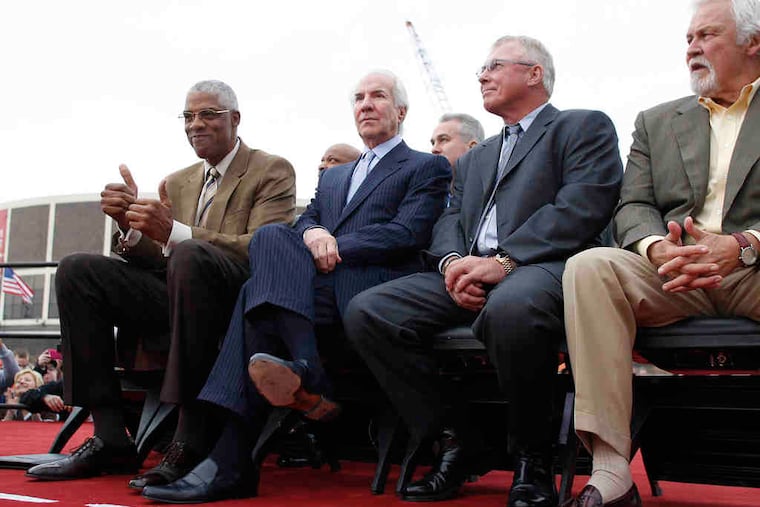Philly's Spectrum gives way to the wrecking ball
Forty-three years after sporting competition debuted there with Joe Frazier's devastating left hooks, the Spectrum's demolition began Tuesday afternoon with a series of soft jabs to its brick and glass exterior.

Forty-three years after sporting competition debuted there with Joe Frazier's devastating left hooks, the Spectrum's demolition began Tuesday afternoon with a series of soft jabs to its brick and glass exterior.
Beneath gray skies symbolic of the funereal mood, a crowd of several thousand Philadelphia sports fans - passionate, sentimental and a bit shabby - gathered on the Spectrum's south side to witness both its demolition and the formal goodbyes from some of the graying performers who had starred there.
"It's a sad day," said ex-76ers great Julius Erving, "because some memories will be taken away." That process began at 12:33 p.m. when, more than a year after the South Philadelphia arena formally closed, a four-ton orange wrecking ball began a surprisingly tentative assault on the multipurpose facility once billed as "America's Showplace."
A Comcast-Spectacor official said it would take "four to five months" for the building to be razed. Sometime after that, the first phase of Philly Live, a retail, entertainment and dining development aimed at capitalizing on its proximity to the busy sports complex, will get started.
As fans and the assembled sports, business and political leaders looked on, the giant ball, suspended from a 180-foot-high Geppert Bros. crane, required several blows to poke a tiny perforation in the building's brown, sardine can-shaped facade.
The first few mechanical punches, accompanied at first by Bruce Springsteen's "Wrecking Ball" and then John Mellencamp's "Crumblin' Down," kicked up only little puffs of dust. Before long the fans, many of whom had been anticipating a more dramatic fall, began drifting away.
Comcast-Spectacor officials explained that the building's structure was not ideally suited for implosion and that this more deliberate destruction also would permit more of its bricks and iron to be salvaged. Its bricks, by the way, can be purchased for $39.95 apiece.
While Erving's belated arrival drew the day's loudest cheers and while his Sixers had won the 1983 NBA title while tenants there, the Spectrum's "Last Shot" ceremony had the distinct orange flavor of the building's other primary occupants, the Flyers.
Many spectators wore Flyers jerseys that bore the names of stars from disparate eras, ranging from the Broad Street Bullies' Dave Schultz to the current team's Mike Richards.
"We will always remember the Spectrum," said Bobby Clarke, the Hall of Fame captain of those Bullies. "God bless the Spectrum."
Clarke, Schultz and teammates Bernie Parent, Joe Watson, Bill Clement, and Bob Kelly were on hand for the noon ceremony, as were several other club officials, including Ed Snider, the Flyers' longtime owner and Comcast-Spectacor's chairman.
Snider admitted to "mixed emotions," noting he was sad to see the building he'd help conceive get torn down but happy that Philly Live will give his hometown "something no other city in America has."
Like most modern arenas, the Spectrum had several corporate sponsors during its final decades. Looking across the parking lot at its newer, grander sister facility, Snider alluded to that trend, calling it the "Wells Fargo, or whatever it's called now, Center."
Clarke's Broad Street Bullies won consecutive Stanley Cups in 1974 and 1975, the first title provoking a gigantic Center City parade that Mayor Nutter admitted attending after leaving St. Joseph's Prep "somewhat early."
"It's not really the end of an era," Nutter said, trying to paint an optimistic face on the happenings. "It's really the start of a new one for our great city. . . . There will always be something going on at PhillyLive."
Erving, after being introduced by the recorded voice of Dave Zinkoff, the 76ers' long-dead P.A. announcer, gave the day's longest speech, a rambling address highlighted by his recollection of the night Santa Claus got involved in a Spectrum brawl.
For a Christmas season game one year, the arena's security personnel dressed up like Santa Claus. During the game, they responded to a fight in the stands.
"I looked up and the Santa Clauses were throwing haymakers at the unruly fans," said Erving, "and the fans were returning the favor. We had to stop the game and check that out!"
The building also hosted circuses, truck shows, lacrosse, college basketball and, like that debut Frazier-Tony Doyle bout on Oct. 17, 1967, several fights. There also were thousands of rock concerts over the years, most notably 50 by the Grateful Dead and 51 by Springsteen.
Comcast-Spectacor president Peter Luuko recalled the "funny smell" that accompanied those Dead shows in particular, a reference to the popularity of marijuana among that group's fans.
When it opened in the fall of 1967, the city's first modern arena had only one sporting neighbor, JFK Stadium, an enormous and ancient facility that hosted the annual Army-Navy Game and little else.
But for the last years of its existence, the Spectrum was the runt in a sporting litter that included three newer, grander structures - the Wells Fargo Center, Citizens Bank Park, and Lincoln Financial Field.
"We will hold the memories of the Spectrum in our minds and our hearts forever," said Erving, "and I hold that I will forever be one of Philadelphia's favorite sons."